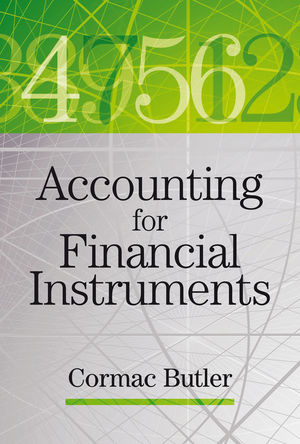Accounting for Financial InstrumentsISBN: 978-0-470-69980-5
Hardcover
296 pages
March 2009
 This is a Print-on-Demand title. It will be printed specifically to fill your order. Please allow an additional 15-20 days delivery time. The book is not returnable.
|
||||||
Preface xi
1 Introduction 1
1.1 Introduction 1
1.2 Scope of the book 4
1.3 Background 6
1.4 Concerns over the misuse of financial instruments 8
1.5 Complexity 10
1.6 Revenue recognition 11
1.7 Inappropriate reward incentives 11
1.8 Protection for shareholders 15
1.9 Measuring the ‘traders’ dilemma’ 16
2 Accounting Foundations 21
2.1 Introduction 21
2.2 IASB improvements 22
2.3 The framework 23
2.4 Fair value or cost 24
2.5 Artificial volatility 26
2.6 Cost model 28
2.7 Cherry-picking 28
2.8 Subjective valuations 29
2.9 Proactive vs. reactive 29
2.10 Goodwill 29
2.11 Market value accounting 30
2.12 IFRS and its contribution to banking crises 31
2.13 IFRS post-Enron 32
2.14 Conclusion 41
3 Corporate Governance 43
3.1 Introduction 43
3.2 Corporate governance 44
3.3 Small vs. large shareholdings 45
3.4 Traders’ dilemma 46
3.5 Moral hazard 47
3.6 Credit rating agencies I 48
3.7 Shareholder democracy 49
3.8 Structured products 50
3.9 Revenue recognition 53
3.10 Non-consolidation 54
3.11 Credit rating agencies II 57
3.12 Accounting standards and lobbying 59
3.13 Investment entities 60
3.14 Conclusion 61
Appendix: Constant proportion debt obligations 62
4 Hedge Accounting 65
4.1 Introduction 65
4.2 Accounting for forward contracts 66
4.3 Accounting pre-IAS 39 67
4.4 Artificial volatility 68
4.5 Hedge accounting rules 69
4.6 Example: Forward rate agreement 74
4.7 Conclusion 76
5 Illustrative Examples: Hedge Accounting 77
5.1 Introduction 77
5.2 Illustration: Fair value hedge 78
5.3 Credit spreads 83
5.4 Cash flow interest rate swaps 91
5.5 Time value vs. change in interest rates 94
5.6 Long method fair value hedge 97
5.7 Foreign exchange hedge 100
Appendix: Documentation 114
6 Accounting for Structured Products (Market Risk) 117
6.1 Introduction 117
6.2 Risk adjusted return on capital 118
6.3 Bifurcation rules 120
6.4 The reward for risk 121
6.5 Protection for shareholders 121
6.6 Illustration: The structured products problem 122
6.7 The accounting treatment under embedded derivative rules 126
6.8 Past mistakes 127
6.9 Conclusion 128
Appendix 6.1: Overview of embedded derivative rules in international accounting reporting standards 129
Appendix 6.2: Introduction to derivatives 129
7 Accounting for Credit Risk 139
7.1 Introduction 139
7.2 Loan approvals 142
7.3 Credit spreads 144
7.4 Accounting standards 146
7.5 Credit rating agencies 147
7.6 Credit derivatives 148
7.7 Accounting for loans 151
7.8 Changes in the accounting standards 153
7.9 Accounting rules on credit derivatives and financial guarantees 156
7.10 Structured credit products: an extra layer of complexity 156
8 Accounting for Structured Products (Credit Risk) 159
8.1 Introduction 159
8.2 Securitisation overview 160
8.3 Regulatory arbitrage 162
8.4 Prepayment risk synthetic securitisations 162
8.5 Accounting for credit risk 164
8.6 Accountants, regulators and credit agencies 165
8.7 Complexity 168
8.8 Disclosure 169
8.9 Credit Suisse fiasco 169
8.10 Monoline insurance companies 171
8.11 Accounting implications 172
8.12 First to default 173
8.13 SFAS 157 valuations 174
8.14 Conclusion 174
9 Off-Balance Sheet Accounting 177
9.1 Introduction 177
9.2 Off-balance sheet manipulation 178
9.3 Case studies: off-balance sheet 180
9.4 Accounting implications 185
10 Reconciliation 199
10.1 Introduction 199
10.2 Middle office 201
10.3 Initial and variation margin 204
10.4 Example: Illustration of reconciliation 208
10.5 Conclusion 216
11 Moving Towards Mark-to-Market Accounting 217
11.1 Introduction 217
11.2 Liquidity and fair value 217
11.3 Banking vs. trading book 219
11.4 VaR 223
11.5 Basel 2 230
11.6 Accounting for VaR and IFRS 7 235
11.7 Conclusion 241
12 Accounting for Insurance 243
12.1 Introduction 243
12.2 Significance of insurance risk 244
12.3 IFRS vs. embedded value reporting 248
12.4 Finite insurance and unbundling 250
12.5 Other aspects of IFRS 4 252
12.6 Phase two embedded value 253
Appendix: The collapse of AIG 255
13 Conclusion 259
Glossary 265
Index 267



